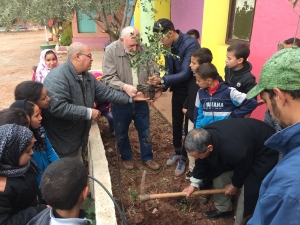Jack Butler, Ph.D
High Atlas Foundation Volunteer
The High Atlas Foundation produces trees. And in the process, it helps people at every step along the way. From schools and youth support centers where High Atlas tree nurseries teach disadvantaged children the healing aspects of farming while they help to grow transplants, to destination family farms where a historically nomadic population gets a chance at a more settled and prosperous life. One by one, the trees are helping to transform arid land on the edge of the Sahara Desert in one of Morocco’s poorest provinces into living, breathing, productive orchards that create prosperity and remove thousands of tons of carbon from the atmosphere each year.
I have spent the past three weeks as a volunteer for the High Atlas Foundation helping farmers in Eastern Morocco use efficient irrigation technology to grow trees with minimal impact on the delicate desert environment. In this arid land, water can be found just beneath the surface, but it must be used sparingly as the aquifer is a limited resource that can be depleted with time. Drip irrigation, in particular, helps farmers make the best possible use of each liter of water, while completely eliminating runoff and percolation of farming chemicals into the groundwater. However, the introduction of drip irrigation will require a new, more scientific approach to crop production in this poor area where literacy rates are low. It requires farmer education and it requires financial resources.
My first stop was at the Center for the Protection of Children in Oujda, a mid-sized city about 60 kilometers from the Mediterranean coast. The Center provides housing and vocational education to children ranging from twelve to eighteen years of age who have been convicted of minor crimes, as well as orphans and abandoned children. High Atlas is in the process of installing a nursery at the Center, capable of growing up to 40,000 trees, where the children will receive valuable hands-on training in farming and will experience the profound therapeutic effects of tending to living plants.
But there are technical problems. The well that supplies water to the Center does not have adequate capacity to supply the nursery and drilling a new one is prohibitively expensive. The current well can be deepened at reasonable cost, but it is unclear how much additional water this will produce. While at the Center I helped High Atlas staff develop a plan to upgrade the well, size the nursery to match the output of the upgraded well and design a drip irrigation system to make efficient use of every drop the well produces. The plan has been finalized and we expect the nursery to be in full production early next year.
After saying goodbye to the children in Oujda our small team headed inland to Bouarfa, the capital of Figuig Province. Bouarfa is the cultural hub of the Bni Guil nomadic tribe, which has tended sheep in Eastern Morocco for over ten centuries. The nomadic life is harsh, and has become more difficult in the past few decades as changes in Morocco’s climate have made surface water more difficult to find and the closing of the Algerian border has hurt the local economy. In the past several years the Provincial government has helped the nomads by giving them land and training to diversify their sheep herding income with farming. It is against this backdrop that we arrived in Bouarfa to help the farmers use drip irrigation to grow high value organic crops with scarce desert resources, and to find homes for some 50,000 fruit and nut trees from High Atlas nurseries.
The farms we visited are small and remote: many less than three hectares, family managed and over fifteen kilometers from the nearest paved road. The government has helped the farmers drill wells and install solar powered pumps which are perfect for this place where the sun is always present and electricity is scarce. According to Dr. Jamal Mimouni, Regional Director of the National Agency for the Development of Oasis Zones (ANDZOA), the region has good soil, plenty of sun, and the desert surroundings hide the fact ground water is plentiful – in some places only three meters below the surface. The farmers are hard-working and eager to create a better life through growing crops, but they need help. Many are new to crop production and information is hard to find in this remote region. They lack both the resources and experience required to adopt environment-friendly, world-class farming practices.
After gathering information, we began work on a plan to transition the farmers from their current use of inefficient flood irrigation to resource-efficient drip systems and to provide them with High Atlas Foundation transplants that were raised in places like the Center for the Protection of Children in Oujda. The plan includes a unique training program catered to specific local needs, drip irrigation equipment and the transplants themselves. Once funded it will enable these small family farmers, less than a generation away from nomadic life, to grow export-quality organic produce using cutting-edge irrigation technology. Yes, the High Atlas Foundation produces trees.




